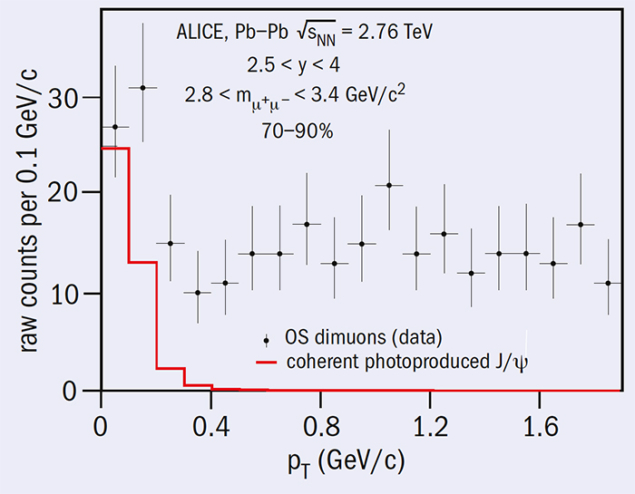
Image credit: ALICE Collaboration.
The nuclear overlap of heavy-ion collisions can be classified based on centrality, which is expressed as a percentile between 0 and 100%, corresponding to head-on and grazing collisions, respectively, or expressed in terms of the impact parameter, which is the distance between the centres of the two colliding nuclei in a plane that is transverse to the beam axis (CERN Courier May 2013 p31). The signal is most clearly seen in the transverse-momentum (pT) distribution shown in figure 1. Hadronically produced J/ψ mesons have a mean pT around 2 GeV/c, and the spectrum shown in figure 1 is consistent with hadronic production down to a pT of about 0.3 GeV/c. Below this value, there is a very strong excess, which cannot be reproduced by any model assuming hadronic production, but which is consistent with the sum of the expected hadronic production plus a contribution from coherently photoproduced J/ψ. This last contribution is shown with the Monte Carlo template in the figure. The yield in this region of phase space is about a factor of seven above what is expected from a scaling of the hadronic yield with the number of binary nucleon–nucleon collisions. This unexpectedly large value implies that there is a physics process at play that has not been taken into account in currently available models. Assuming that the underlying process is photoproduction, ALICE obtained the corresponding cross-section.
While in hadronic collisions the nuclei break, they each act as one entity in coherent photoproduction, where the smallness of the pT is related, via the Heisenberg uncertainty principle, to the size of the lead nucleus. Interestingly, current models of coherent photoproduction integrated over the impact-parameter range corresponding to peripheral collisions predict cross-sections with the right magnitude.
New Pb–Pb collision data at √sNN = 5.02 TeV recorded by ALICE in 2015 should allow us to quantify this excess with higher precision and to evaluate its strength in more central collisions. Whether this new source of very-low-pT J/ψ will provide an additional probe of the properties of the QGP remains an open question.





